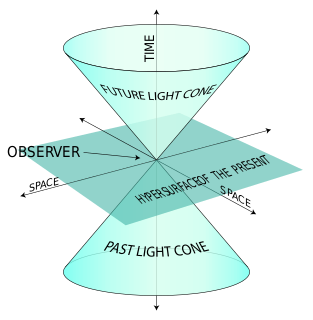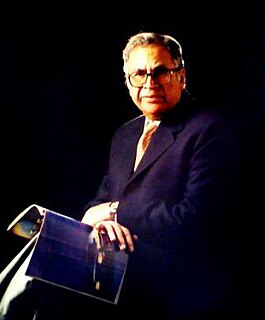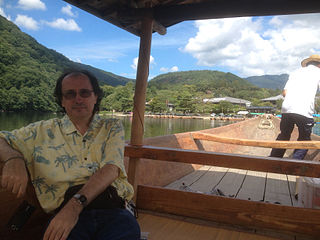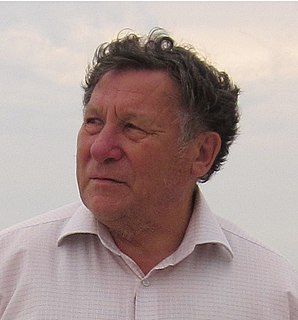Computational chemistry is a branch of chemistry that uses computer simulation to assist in solving chemical problems. It uses methods of theoretical chemistry, incorporated into computer programs, to calculate the structures and properties of molecules, groups of molecules, and solids. It is essential because, apart from relatively recent results concerning the hydrogen molecular ion, the quantum many-body problem cannot be solved analytically, much less in closed form. While computational results normally complement the information obtained by chemical experiments, it can in some cases predict hitherto unobserved chemical phenomena. It is widely used in the design of new drugs and materials.

In mathematics and applied mathematics, perturbation theory comprises methods for finding an approximate solution to a problem, by starting from the exact solution of a related, simpler problem. A critical feature of the technique is a middle step that breaks the problem into "solvable" and "perturbative" parts. In perturbation theory, the solution is expressed as a power series in a small parameter . The first term is the known solution to the solvable problem. Successive terms in the series at higher powers of usually become smaller. An approximate 'perturbation solution' is obtained by truncating the series, usually by keeping only the first two terms, the solution to the known problem and the 'first order' perturbation correction.

Understanding the structure of the atomic nucleus is one of the central challenges in nuclear physics.

The light-front quantization of quantum field theories provides a useful alternative to ordinary equal-time quantization. In particular, it can lead to a relativistic description of bound systems in terms of quantum-mechanical wave functions. The quantization is based on the choice of light-front coordinates, where plays the role of time and the corresponding spatial coordinate is . Here, is the ordinary time, is one Cartesian coordinate, and is the speed of light. The other two Cartesian coordinates, and , are untouched and often called transverse or perpendicular, denoted by symbols of the type . The choice of the frame of reference where the time and -axis are defined can be left unspecified in an exactly soluble relativistic theory, but in practical calculations some choices may be more suitable than others.
Reinhard Oehme was a German-American physicist known for the discovery of C non-conservation in the presence of P (parity) violation, the formulation and proof of hadron dispersion relations, the "Edge of the Wedge Theorem" in the function theory of several complex variables, the Goldberger-Miyazawa-Oehme sum rule, reduction of quantum field theories, Oehme-Zimmermann superconvergence relations for gauge field correlation functions, and many other contributions.

Dmitry Vasil'evich Shirkov was a Russian theoretical physicist, known for his contribution to quantum field theory and to the development of the renormalization group method.

Riazuddin, also spelled as Riaz-Ud-Din, was a Pakistani theoretical physicist, specialising in high-energy physics and nuclear physics. Starting his scientific research in physics in 1958, Riazuddin was considered one of the early pioneers of Pakistan's nuclear weapons development and atomic deterrence development. He was the director of the Theoretical Physics Group (TPG) of the Pakistan Atomic Energy Commission (PAEC) from 1974 until 1984. Riazuddin was a pupil of the winner of the 1979 Nobel Prize in Physics, Abdus Salam.
Alfred H. Mueller is an American theoretical physicist, and the Enrico Fermi Professor of Physics at Columbia University.

Piotr Piecuch is a Polish-born American physical chemist. He holds the title of University Distinguished Professor in the Department of Chemistry at Michigan State University, East Lansing, Michigan, United States. He supervises a group, whose research focuses on theoretical and computational chemistry as well as theoretical and computational physics, particularly on the development and applications of many-body methods for accurate quantum calculations for molecular systems and atomic nuclei, including methods based on coupled cluster theory, mathematical methods of chemistry and physics, and theory of intermolecular forces. His group is also responsible for the development of the coupled-cluster computer codes incorporated in the widely used GAMESS (US) package.
John Clements Collins is a British-born American theoretical physicist and professor of physics at Pennsylvania State University. He attended the University of Cambridge where he obtained a B.A. in mathematics 1971 and a Ph.D. in theoretical physics in 1975. He worked as a postdoc and assistant professor from 1975 to 1980 at Princeton University. Collins was part of the faculty of the Illinois Institute of Technology from 1980 to 1990. From 1990 to the present, he has been a faculty member in the department of physics at Pennsylvania State University where he currently holds the position of Distinguished Professor. He is a Fellow of the American Physical Society and received the Guggenheim Fellowship in 1986. In 2009, he was awarded the Sakurai Prize along with R. Keith Ellis and Davison E. Soper.

The light-front quantization of quantum field theories provides a useful alternative to ordinary equal-time quantization. In particular, it can lead to a relativistic description of bound systems in terms of quantum-mechanical wave functions. The quantization is based on the choice of light-front coordinates, where plays the role of time and the corresponding spatial coordinate is . Here, is the ordinary time, is a Cartesian coordinate, and is the speed of light. The other two Cartesian coordinates, and , are untouched and often called transverse or perpendicular, denoted by symbols of the type . The choice of the frame of reference where the time and -axis are defined can be left unspecified in an exactly soluble relativistic theory, but in practical calculations some choices may be more suitable than others. The basic formalism is discussed elsewhere.

The light-front quantization of quantum field theories provides a useful alternative to ordinary equal-time quantization. In particular, it can lead to a relativistic description of bound systems in terms of quantum-mechanical wave functions. The quantization is based on the choice of light-front coordinates, where plays the role of time and the corresponding spatial coordinate is . Here, is the ordinary time, is one Cartesian coordinate, and is the speed of light. The other two Cartesian coordinates, and , are untouched and often called transverse or perpendicular, denoted by symbols of the type . The choice of the frame of reference where the time and -axis are defined can be left unspecified in an exactly soluble relativistic theory, but in practical calculations some choices may be more suitable than others.

Eduard Alekseevich Kuraev — Soviet and Russian theoretical physicist. Doctor of Physical and Mathematical Sciences (1971).

In nuclear physics, ab initio methods seek to describe the atomic nucleus from the bottom up by solving the non-relativistic Schrödinger equation for all constituent nucleons and the forces between them. This is done either exactly for very light nuclei or by employing certain well-controlled approximations for heavier nuclei. Ab initio methods constitute a more fundamental approach compared to e.g. the nuclear shell model. Recent progress has enabled ab initio treatment of heavier nuclei such as nickel.
Dean Lee is an American nuclear theorist, researcher and educator. He is a Professor of Physics at the Facility for Rare Isotope Beams and Department of Physics and Astronomy at Michigan State University.
Hiroshi Enatsu was a Japanese theoretical physicist who contributed to a relativistic Hamiltonian formalism in quantum field theory.

Usha Kulshreshtha is an Indian theoretical physicist, specializing in the Dirac's instant-form and light-front quantization of quantum field theory models, string theory models and D-brane actions using the Hamiltonian, path integral and BRST quantization methods, constrained dynamics, construction of gauge theories and their quantizaton under gauge-fixing as well as study of boson stars, and wormholes in general relativity and gravity theory.
Anna Hasenfratz is a Hungarian-American theoretical high energy physicist whose research involves non-perturbative theories, especially in lattice quantum chromodynamics. She is a professor of physics at the University of Colorado Boulder.
Arthur Kent Kerman was a Canadian-American nuclear physicist, a fellow of the American Physical Society, Fellow of the American Academy of Arts and Sciences, and Fellow of the New York Academy of Sciences. He was a professor emeritus of physics at Massachusetts Institute of Technology’s Center for Theoretical Physics (CTP) and Laboratory for Nuclear Science. He was known for his work on the theory of the structure of nuclei and on the theory of nuclear reactions.
Zoltan Fodor is a Hungarian theoretical particle physicist, best known for his works in lattice QCD by numerically solving the theory of the strong interactions.







